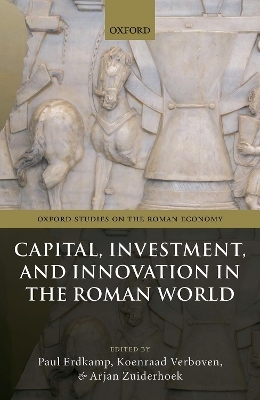
Capital, Investment, and Innovation in the Roman World
Oxford University Press (Verlag)
978-0-19-884184-5 (ISBN)
Investment in capital, both physical and financial, and innovation in its uses are often considered the linchpin of modern economic growth, while credit and credit markets now seem to determine the wealth - as well as the fate - of nations. Yet was it always thus? The Roman economy was large, complex, and sophisticated, but in terms of its structural properties did it look anything like the economies we know and are familiar with today?
Through consideration of the allocation and uses of capital and credit and the role of innovation in the Roman world, the individual essays comprising this volume go straight to the heart of the matter, exploring such questions as how capital in its various forms was generated, allocated, and employed in the Roman economy; whether the Romans had markets for capital goods and credit; and whether investment in capital led to innovation and productivity growth. Their authors consider multiple aspects of capital use in agriculture, water management, trade, and urban production, and of credit provision, finance, and human capital, covering different periods of Roman history and ranging geographically across Italy and elsewhere in the Roman world. Utilizing many different types of written and archaeological evidence, and employing a range of modern theoretical perspectives and methodologies, the contributors, an expert international team of historians and archaeologists, have produced the first book-length contribution to focus exclusively on (physical and financial) capital in the Roman world; a volume that is aimed not only at specialists in the field, but also at economic historians and archaeologists specializing in other periods and places.
Paul Erdkamp is Professor of Ancient History at the Vrije Universiteit Brussel, where he has taught since 2007. He studied history at the Radboud University of Nijmegen, obtaining his PhD in 1998, before holding teaching posts at the universities of Edinburgh, Utrecht, and Nijmegen and a research fellowship at Leiden University. He is co-director with Koenraad Verboven of the Roman Society Research Centre (Ghent/Brussels) and general editor of the Palgrave Studies in Ancient Economies series, and has published widely on the Roman economy, the Roman army, and Roman Republican historiography. Koenraad Verboven is Professor of Ancient History at Ghent University, where he has taught since 2007. He specializes in ancient social and economic history, particularly of the Roman world, and has a special interest in monetary history and numismatics, friendship and patronage based networks, guilds (collegia), (neo-)institutional analysis, and complexity economics. He is the author of The Economy of Friends: Economic Aspects of Amicitia and Patronage in the Late Republic (Peeters, 2002), for which he was awarded the 'Prix Joseph Gantrelle' of the Belgian Royal Academy. Arjan Zuiderhoek is Professor of Ancient History at Ghent University, where he has taught since 2008. He studied Greek and Roman history at the University of Groningen and the University of Cambridge and obtained his PhD at the University of Groningen in 2006 before taking up positions as Junior Research Fellow and Director of Studies in Classics at Homerton College, University of Cambridge and, subsequently, Postdoctoral Research Fellow at Ghent University. He is the author of The Politics of Munificence in the Roman Empire: Citizens, Elites and Benefactors in Asia Minor (CUP, 2009) and The Ancient City (CUP, 2017).
Frontmatter
List of Figures
List of Tables
List of Abbreviations
List of Contributors
1: Paul Erdkamp, Koenraad Verboven, and Arjan Zuiderhoek: Introduction
I. Investment and Innovation
2: Paul Erdkamp: Population, Technology, and Economic Growth in the Roman World
3: Cristiano Viglietti: Innovations and Uses of Wealth in Archaic Rome and Latium (Late Eighth to Early Fourth Century BC)
4: Wim Broekaert and Arjan Zuiderhoek: Capital Goods in the Roman Economy
5: Andrew Wilson: Roman Water-Power: Chronological Trends and Geographical Spread
6: Nicolas Monteix: The Archaeological Perception of Capital and its Transformations in Urban Occupations
II. Capital and Investment in the Rural Economy
7: Marguerite Ronin: Funding Irrigation: Between Individual and Collective Investments
8: Mick Stringer: Impensae, operae, and the pastio uillatica: The Evaluation of New Venture Investments in the Roman Agricultural Treatises
9: Annalisa Marzano: A Story of Land and Water: Control, Capital, and Investment in Large-Scale Fishing and Fish-Salting Operations
10: Tamara Lewit: Invention, Tinkering, or Transfer? Innovation in Oil and Wine Presses in the Roman Empire
III. Human Capital, Financial Capital, and Credit Markets
11: Norman Underwood: Labouring for God: The Clergy and Human Capital in the Later Roman Empire
12: Koenraad Verboven: Capital Markets and Financial Entrepreneurs in the Roman World
13: Jean Andreau: Capital and Investment in the Campanian Tablets
14: Merav Haklai: Credit and Financial Capital in Roman Egypt
15: Leonardo Gregoratti: Temples and Traders in Palmyra
Endmatter
Index
| Erscheinungsdatum | 02.04.2020 |
|---|---|
| Reihe/Serie | Oxford Studies on the Roman Economy |
| Zusatzinfo | 53 black-and-white illustrations |
| Verlagsort | Oxford |
| Sprache | englisch |
| Maße | 164 x 241 mm |
| Gewicht | 1032 g |
| Themenwelt | Geisteswissenschaften ► Archäologie |
| Geschichte ► Allgemeine Geschichte ► Vor- und Frühgeschichte | |
| Geschichte ► Allgemeine Geschichte ► Altertum / Antike | |
| Geschichte ► Teilgebiete der Geschichte ► Wirtschaftsgeschichte | |
| Wirtschaft ► Allgemeines / Lexika | |
| ISBN-10 | 0-19-884184-1 / 0198841841 |
| ISBN-13 | 978-0-19-884184-5 / 9780198841845 |
| Zustand | Neuware |
| Informationen gemäß Produktsicherheitsverordnung (GPSR) | |
| Haben Sie eine Frage zum Produkt? |
aus dem Bereich


